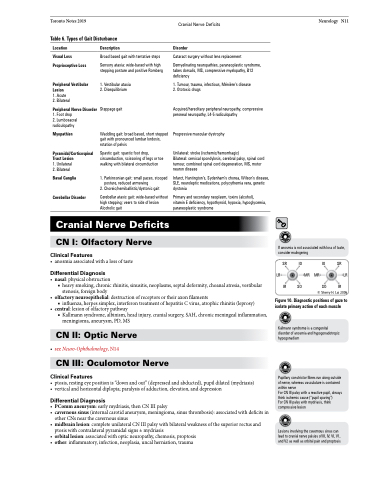Page 753 - TNFlipTest
P. 753
Toronto Notes 2019
Cranial Nerve Deficits
Neurology N11
Table 6. Types of Gait Disturbance
Location
Visual Loss Proprioceptive Loss
Peripheral Vestibular Lesion
1. Acute
2. Bilateral
Peripheral Nerve Disorder
1. Foot drop
2. Lumbosacral radiculopathy
Myopathies
Pyramidal/Corticospinal Tract Lesion
1. Unilateral
2. Bilateral
Basal Ganglia Cerebellar Disorder
Description
Broad based gait with tentative steps
Sensory ataxia: wide-based with high stepping posture and positive Romberg
1. Vestibular ataxia 2. Disequilibrium
Steppage gait
Waddling gait: broad based, short stepped gait with pronounced lumbar lordosis, rotation of pelvis
Spastic gait: spastic foot drop, circumduction, scissoring of legs or toe walking with bilateral circumduction
1. Parkinsonian gait: small paces, stooped posture, reduced armswing
2. Choreic/hemiballistic/dystonic gait
Cerebellar ataxic gait: wide-based without high stepping; veers to side of lesion Alcoholic gait
Disorder
Cataract surgery without lens replacement
Demyelinating neuropathies, paraneoplastic syndrome, tabes dorsalis, MS, compressive myelopathy, B12 deficiency
1. Tumour, trauma, infectious, Ménière’s disease 2. Ototoxic drugs
Acquired/hereditary peripheral neuropathy, compressive peroneal neuropathy, L4-5 radiculopathy
Progressive muscular dystrophy
Unilateral: stroke (ischemic/hemorrhagic)
Bilateral: cervical spondylosis, cerebral palsy, spinal cord tumour, combined spinal cord degeneration, MS, motor neuron disease
Infarct, Huntington’s, Sydenham’s chorea, Wilson’s disease, SLE, neuroleptic medications, polycythemia vera, genetic dystonia
Primary and secondary neoplasm, toxins (alcohol), vitamin E deficiency, hypothyroid, hypoxia, hypoglycemia, paraneoplastic syndrome
Cranial Nerve Deficits
CN I: Olfactory Nerve
Clinical Features
• anosmiaassociatedwithalossoftaste
Differential Diagnosis
If anosmia is not associated with loss of taste, consider malingering
• nasal:physicalobstruction
■ heavy smoking, chronic rhinitis, sinusitis, neoplasms, septal deformity, choanal atresia, vestibular
stenosis, foreign body
• olfactoryneuroepithelial:destructionofreceptorsortheiraxonfilaments
■ influenza, herpes simplex, interferon treatment of hepatitis C virus, atrophic rhinitis (leprosy) • central:lesionofolfactorypathway
■ Kallmann syndrome, albinism, head injury, cranial surgery, SAH, chronic meningeal inflammation, meningioma, aneurysm, PD, MS
CN II: Optic Nerve
• seeNeuro-Ophthalmology,N14
CN III: Oculomotor Nerve
Clinical Features
• ptosis,restingeyepositionis“downandout”(depressedandabducted),pupildilated(mydriasis) • verticalandhorizontaldiplopia;paralysisofadduction,elevation,anddepression
Differential Diagnosis
• PCommaneurysm:earlymydriasis,thenCNIIIpalsy
• cavernoussinus(internalcarotidaneurysm,meningioma,sinusthrombosis):associatedwithdeficitsin
other CNs near the cavernous sinus
• midbrainlesion:completeunilateralCNIIIpalsywithbilateralweaknessofthesuperiorrectusand
ptosis with contralateral pyramidal signs ± mydriasis
• orbital lesion: associated with optic neuropathy, chemosis, proptosis
• other:inflammatory,infection,neoplasia,uncalherniation,trauma
LR
SR IO IO SR MR MR LR
IR SO SO IR
© Sherry H. Lai 2006
Figure 10. Diagnostic positions of gaze to isolate primary action of each muscle
Kallmann syndrome is a congenital disorder of anosmia and hypogonadotropic hypogonadism
Pupillary constrictor fibres run along outside of nerve, whereas vasculature is contained within nerve
For CN III palsy with a reactive pupil, always think ischemic cause (“pupil sparing”)
For CN III palsy with mydriasis, think compressive lesion
Lesions involving the cavernous sinus can lead to cranial nerve palsies of III, IV, VI, V1, and V2 as well as orbital pain and proptosis


